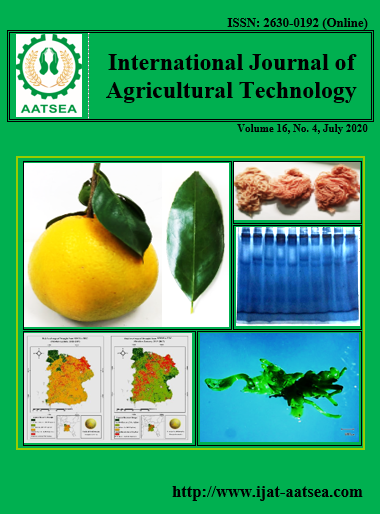Optimization of culture parameters of selenium-enriched Ophiocordyceps sinensis biomass by response surface methodology
Main Article Content
Abstract
The medium composition and culture conditions of 25 mg/L selenium supplementing Ophiocordyceps sinensis was optimized by response surface methodology. The results showed that the optimum medium for Se enrichment of O. sinensis found to be 53.48 g/L saccharose, 11.17 g/L peptone, 1.05 g/L KH2PO4. The biomass and selenium content was 24,93 g/L, 960,31 µg/g, respectively. The obtained optimum conditions for O. sinensis consisted of daylight, temperature 20 °C, initial pH value 6.1. The maximum biomass and total Se yield reached 26,45 g/L, 1068 µg/g, respectively. The result indicated that response surface methodology is a promising method for the optimization of selenium-enriched O. sinensis fermentation process, and which is the basis for further studies of the fungal bioactivity.
Article Details

This work is licensed under a Creative Commons Attribution-NonCommercial-NoDerivatives 4.0 International License.
References
Ba-Abbad, M. M., Kadhum, A. A. H., Mohamad, A. B., Takriff, M. S. and Sopian, K. (2013). Optimization of process parameters using D-optimal design for synthesis of ZnO nanoparticles via sol–gel technique. Journal of Industrial and Engineering Chemistry, 19:99-105.
Belwal, T., Bhatt, I. D., Kashyap, D., Sak, K., Tuli, H. S., Pathak, R., Rawal, R. S. and Ghatnur, S. M. (2019). Ophiocordyceps sinensis. Nonvitamin and Nonmineral Nutritional Supplements, Elsevier, 527-537.
Brown, K. M. and Arthur, J. (2001). Selenium, selenoproteins and human health: a review. Public Health Nutrition, 4:593-599.
Dong, C. H. and Yao, Y. J. (2005). Nutritional requirements of mycelial growth of Cordyceps sinensis in submerged culture. Journal of Applied Microbiology, 99:483-492.
Dong, J. Z., Lei, C., Ai, X. R. and Wang, Y. (2012). Selenium enrichment on Cordyceps militaris link and analysis on its main active components. Applied biochemistry and biotechnology, 166:1215-1224.
Esmaeili, S. and Khosravi-Darani, K. (2014). Selenium-enriched yeast: As selenium source for nutritional purpose. Current Nutrition & Food Science, 10:49-56.
Fairweather-Tait, S. J., Bao, Y., Broadley, M. R., Collings, R., Ford, D., Hesketh, J. E. and Hurst, R. (2011). Selenium in human health and disease. Antioxidants & redox signaling, 14:1337-1383.
Ferreira, S. C., Bruns, R., Ferreira, H., Matos, G., David, J., Brandao, G., da Silva, E. P., Portugal, L., Dos Reis, P. and Souza, A. (2007). Box-Behnken design: an alternative for the optimization of analytical methods. Analytica Chimica Acta, 597:179-186.
Fung, S. Y., Lee, S. S., Tan, N. H. and Pailoor, J. (2017). Safety assessment of cultivated fruiting body of Ophiocordyceps sinensis evaluated through subacute toxicity in rats. Journal of Ethnopharmacology, 206:236-244.
Hoa, H. T. and Wang, C. L. (2015). The effects of temperature and nutritional conditions on mycelium growth of two oyster mushrooms (Pleurotus ostreatus and Pleurotus cystidiosus). Mycobiology, 43:14-23.
Jiapeng, T., Yiting, L. and Li, Z. (2014). Optimization of fermentation conditions and purification of cordycepin from Cordyceps militaris. Preparative Biochemistry and Biotechnology, 44:90-106.
Kang, C., Wen, T.-C., Kang, J.-C., Meng, Z.-B., Li, G.-R. and Hyde, K. D. (2014). Optimization of large-scale culture conditions for the production of cordycepin with Cordyceps militaris by liquid static culture. The Scientific World Journal, 2014.
Kim, S. W., Hwang, H. J., Xu, C. P., Sung, J. M., Choi, J. W. and Yun, J. W. (2003). Optimization of submerged culture process for the production of mycelial biomass and exo‐polysaccharides by Cordyceps militaris C738. Journal of Applied Microbiology, 94:120-126.
Le, Q. P., Nguyen, T. H., Pham, T. M. N., Tran, M. T., Dinh, M. H. and Ngo, K. S. (2017). Surveying the effect of nutrient composition on biomass production of Ophiocordyceps sinensis fungus in selenium-enriched medium. Journal of Biotechnology, 15:1-8.
Milovanović, I., Brčeski, I., Stajić, M., Korać, A., Vukojević, J. and Knežević, A. (2014). Potential of Pleurotus ostreatus mycelium for selenium absorption. The Scientific World Journal, 2014.
Pacquette, L. H., Szabo, A. and Thompson, J. J. (2011). Simultaneous determination of chromium, selenium, and molybdenum in nutritional products by inductively coupled plasma/mass spectrometry: single-laboratory validation. Journal of AOAC International, 94:1240-1252.
Rayman, M. P. (2012). Selenium and human health. The Lancet, 379:1256-1268.
Singh, S., Ranjan, S., Negi, P. S. and Arif, M. (2014). Optimization of Nutritional Necessities for in vitro Culture of Ophiocordyceps Sinensis. International Journal of Science and Research, 3:1523-1528.
Xiao, J., Chen, D., Liu, J., Liu, Z., Wan, W., Fang, N., Xiao, Y., Qi, Y. and Liang, Z. (2004). Optimization of submerged culture requirements for the production of mycelial growth and exopolysaccharide by Cordyceps jiangxiensis JXPJ 0109. Journal of Applied Microbiology, 96:1105-1116.
Yin, H., Chen, Z., Gu, Z. and Han, Y. (2009). Optimization of natural fermentative medium for selenium-enriched yeast by D-optimal mixture design. LWT-Food Science and Technology, 42:327-331.
Yu, S. J., Zhang, Y. and Fan, M. Z. (2011). Analysis of volatile compounds of mycelia of Hirsutella sinensis, the anamorph of Ophiocordyceps sinensis. Applied Mechanics and Materials, 140:253-257.
Zhang, H., Zhang, H. M., Han, L. and Wang, S. H. (2014). Cultivation Technique of Selenium-Enriched Cordyceps militaris. Applied Mechanics and Materials, 522-524:1147-1150.
Zheng, L., Hao, L., Ma, H., Tian, C., Li, T., Sun, X., Jia, M. and Jia, L. (2014). Production and in vivo antioxidant activity of Zn, Ge, Se-enriched mycelia by Cordyceps sinensis SU-01. Current microbiology, 69:270-276.


